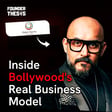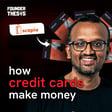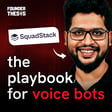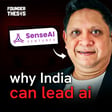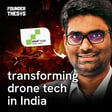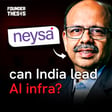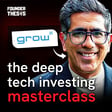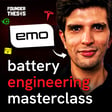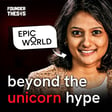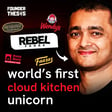Types of Entrepreneurs
00:00:00
Speaker
Hi, I am am H B Singh, Chairman and Managing Director of Saturn Great K Network Limited. It's an NPSC MFI.
00:00:21
Speaker
There are two types of entrepreneurs that we celebrate. The first one is the founder who raised a lot of money and built a highly valued startup on the back of investor money. The second type of entrepreneur, which we think is really the more special type of entrepreneur, is the one who has started from scratch and built up a business brick by brick on the back of his hustle and grit.
H.B. Singh's Entrepreneurial Journey
00:00:43
Speaker
H.B. Singh is a great example of the second type of entrepreneur. He was a CA who accidentally got a chance to start a lending business in the 1990s and has since then built up satin credit care into one of the few listed microfinance companies in India, which today employs about 12,000 people and has a market capitalization of 2,000 crores.
00:01:03
Speaker
This is truly a story of the old-fashioned approach of building a business using grit, resilience, and a bit of luck. And H.B. Singh shares tons of lessons for aspiring entrepreneurs.
Role of NBFC MFI in Microfinance
00:01:14
Speaker
Stay tuned and subscribe to the Founder Thesis Podcast on any Orchard streaming app. So, H.B., help me understand the the business of Saturn credit card. You said it is an NBFC MFI. Can you break down these arguments for people who are not from the industry?
00:01:33
Speaker
So when I said this is NBFC MFI means that ah we do microfinance business in India. It's a category which has been created by Reserve Bank of India. It's kind of a, ah we get a license basically that we we do microfinance. So it's microfinance loans, which we generally give to rural women in India.
00:01:56
Speaker
ah these are productive loans means they whatever loans we give actually generate some income for the borrower as such and that is the reason why these are called productive loans you know we don't give loans for any ah kind of a consumption ah this is related to majorly the agriculture and agriculture allied activities that could be ah dairy farming, cattle raring, farming as such, ah vegetable vending, and any very so and any anything you know which is related to agriculture to the to the most part.
Microfinance vs. Asset Loans
00:02:30
Speaker
And that is what we give you know credit for ah for this kind of activity.
00:02:36
Speaker
How is microfinance different from, ah say, a company which gives out a two-wheeler loan? Two-wheeler is an asset class. and also So when you're giving out a loan for a two-wheeler, that means you're acquiring an asset. Over here, there is no acquisition of an asset. It is just for your need of ah developing your business or making your business run far more smoothly with more credit coming in so that it actually enhances your income generating capabilities. That's the difference between two-wheelers and this.
00:03:10
Speaker
I wouldn't understand the term microfinance. Technically, is it only referring to the ticket size of the loan? These are small ticket size loans, that's it. Or is there some other difference between an MFI lender and a regular lender?
00:03:25
Speaker
ah I think, you know, this used to be there a long time back, you know, that, you know, it was curbed at about 50,000 rupees, maybe in the ancient days of ours, you know, when a micron has just started, you know, but now it's more related towards ah about the income generation, that is part one. Secondly, what we look at, there are certain set ah set of rules, you know, which RBI has conditioned ah as you can give only this much of a loan. ah There will be these many lenders, ah there will be technically, you know, this is the monthly EMI, which probably should be there and the household income which should be there.
00:04:04
Speaker
So these are special categories ah which fit into a
Microfinance License Benefits
00:04:08
Speaker
microphone slo-mo. So this is depicted ah basically by these kind of ah nomenclatures, you know, before we actually say that this is a microphone slo-mo. So that's where the difference lies.
00:04:18
Speaker
So ah you have a license of a microfinance institute. ah Is there a benefit of having that license versus lending without that microfinance license? Because there are all types of NBFCs. Many of them may not have a license, but may still be giving a productive loan, may still be giving a low ticket-sized loan. What does that microfinance license or that tag give you? like Does it give you lower cost of funds? or well like oh I think know the the the beneficial a thing which is attached to doing microferences. If you look at the entire environment of the microferences, they are primarily lending in the rural space. So let's say our company, you know if we've got about 70 to 80% of our lending which is happens in the rural space. you know
00:05:07
Speaker
Now, that is probably one of the key benefits across and you when you say that you're doing microfinance. The second, as a model, this actually gives loans to rural women in the larger frame of things. you know ah That is one of the key aspects when you ah give loan to women. It actually relates yourself to doing ah women empowerment.
00:05:30
Speaker
ah not only in just ah ah terminology or words, but this is actually giving empowerment to women. ah Secondly, I think it really helps also developing ah some form of financial inclusion to a larger space. you know ah Thirdly, I think an which is also very key to this whole gamut of doing microtransfore women is that you actually make financial literacy possible, you know even in the rural landscape.
00:05:56
Speaker
And that is also one of the key reasons why microfinance you know benefits you know such a large, I think, you know constituency of things you know which you're really able to do by doing but women empowerment, helping rural businesses. ah Thirdly, you know looking at financial inclusion in a larger space.
Microfinance and Social Impact
00:06:15
Speaker
And ah fourthly, as I said, so know basically it really helps these businesses grow up and look at maybe enhancing your capability of ah generating more income.
00:06:27
Speaker
other the So one is you're saying that microfinance institutes have and from an impact point of view. There is a net social good. But other than that, is there any difference? Like, do you get funds at a lower cost? Do you get any other benefits of being a microfinance institute? Are there any kind of structures created to enable microfinance institutes to thrive from a regulatory standpoint? like See, a if I talk about cost of funds, I don't think so that we can any kind of ah benefit in terms of we get lower cost of funds just because we do microfinance. ah Even though the category when the banks lend to us, you know they enter into a category which is which they probably have to do it as part of their statutory obligations. you
00:07:18
Speaker
the There is a requirement of priority sector. lening Yeah, so it does enter that category. What is that requirement? How much of a bank's book should be priority sector? Normally I think about 40 odd percent and know is is what the priority sector should be. we good that But then there are other categories also like export credit and everything which also comes in that priority sector.
00:07:40
Speaker
ah But yes, it does give us an advantage that for us, ah probably the flow gets a little better from these banking institutions and other financial financials institutions. ah Plus, I think you know a lot of agenda for foreign institutions you know which are ah technically the DFIs, you know, which we call them, you know, like the IFCs and the ADBs, as well as the sovereign funds, the DFIs of ah various countries of Norway, Denmark and everybody, you know, their agenda is also to promote financial inclusion ah to a large extent. So that also opens up, um you know, funding for us, you know. So I think, you know, that is probably one advantage which we get. But if it translates into lower cost of funds, I don't think so. That's there. That's not there.
00:08:26
Speaker
Okay, interesting. and May I ask what is your average cost of funds? Like how much do you borrow it? We are closer to
From CA to NBFC Innovator
00:08:34
Speaker
about 11.50% right now, which used to be about 12% about six months back. you know so And ah why is it why has it become 11.5% from 12%? Is there some macro environment change or ah has the credit rating improved for the business? or Yeah, that's exactly what it is. you know so It's all probably a function of the rating you know which is there. and know Unfortunately, I think you know but that is what it is. and So if your rating improves, definitely ah you will be having access to ah lower cost of funds. low So that is where I think you know
00:09:13
Speaker
ah The benefits of microphones don't kick in. It's just related to your commercial sense of getting a good rating, be it on the basis of your capital adequacy, be it on the basis of your credit cost and various other factors. you know I think know that is where then every everything of which is more commercial kicks in. And that is the only way you can probably have access to lower cost of funds. and ah Okay. Okay. So what did you do to improve your credit rating? Like we got more capital. We were a little bit more profitable, you know, so as I said, you know, these are, these are commercial terminologies, which will kick in, uh, to give you maybe a better cost of fund. It's not that, you know, I've given a 200,000 more loans to ah more women in a, in a difficult area. And, uh, that's probably one of the reason I can give you a lower cost of fund. and Unfortunately, it doesn't work that way.
00:10:06
Speaker
Okay, interesting. how What is the benchmark like 11.5% as a standalone number? doesn't, I mean, it doesn't give me information of, is this a good number or not? Like how much, say Bajaj Finance, what would be their cost of funds? Bajaj Finance is the largest lender in India, right? No, I probably, you know, but I don't know, they they should not hold me responsible for anything, you know, which I say, but yeah ballpark figure would probably be, they'll be at least about 3% or maybe 3.5% down, up lesser than us. So if we are at 11.5, they would probably be at about,
00:10:44
Speaker
I want since it's about eight and a half. Okay. of manual And this is a factor of their capital base or their profitability or like? it's it's it's They are they're they're a huge company. Capital base is big. ah the The terminology and which carries, you know, it's Bajaj versus Singh, you know, basically.
00:11:06
Speaker
yeah and rather a than they took it ah so So I think, you know, they carry that advantage, you know, definitely which is there. don't know and maybe in the in the commercial structure and sense, you know ah they would have that advantage because they're far more, I think you know they're far more robust robust and they have huge reserves and capital. But I think you know the differentiation between the asset class definitely should have some bearing on you know how it probably should be looked at. Right, right, right. What is your capital adequacy ratio? So capital adequacy ratio is,
00:11:43
Speaker
your equity versus how much you've lent out, like your AUM versus equity, is that the right understanding? Yeah, so capital adequacy means, you know, the the Reserve Bank of India actually specifies ah that we should have 15% capital adequacy. We are currently at about 28% means that we have more capital than the strategy which is required.
00:12:04
Speaker
And that function probably is one of the key reasons why our rating probably has moved after we ah did our last capital raise, moved from A minus to A, which gave us that advantage of maybe about a 50 basis point ah ah you know improvement in the cost of funds. and know So I said, you know it's all a function of You have more capital, you have far more far more robust, ah which definitely is probably the right way when RBI and everybody looks at it. ah But I think you know when ah when we look at the asset class as such, and um my own, that that's my personal opinion. and And I don't want to be hauled off for that. But you know this is what I say. know It's what you deliver. what you deliver And what ah I think you know how does it actually make a difference in the lives of people who are actually getting credit? See?
00:12:52
Speaker
ah but When you look at it, you know, if you look at different asset classes, my own thought processes, you're doing affordable housing finance and you're doing housing finance, you know, now this, why is this far more better because you're giving it to people who are able to have affordable. impact Yeah, when you're doing a housing finance business, you know, I'm buying an apartment for a about, you know, let's say five crore, and you're giving me two crore. Well, that's fine. You know, but it's probably based on that, you know, I'm improving my my status in the in the society by getting a fancy apartment for myself. But over here, this is a need. So my sense is they should be viewed differently.
00:13:32
Speaker
Similarly, when you do microfinance and we're doing a two-wheeler finance, you know, I won't say two-wheeler finance, you're doing a car finance or you're doing maybe a machinery finance or maybe they have their advantages definitely does help businesses as such, you know, but if you really look at it, are we able to reach where probably it's very difficult for people to reach?
00:13:54
Speaker
Give them the banking services as such. you know We actually deliver banking services. You're giving credit to the underserved, underbanked, unbanked population. And the third is, which is very important for everybody to understand. See, we don't talk about women empowerment just by saying that we do it, we actually deliver it.
00:14:17
Speaker
So when we say that our company actually has given currently active loans to about 3.4 million women borrowers means we have actually empowered every woman who's taken
Accidental or Destined Entrepreneur?
00:14:29
Speaker
a loan from us to run her business or the household business as well as try and see how the money will come in, how she's able to repay back and whether it enhances the actual standard of living of their household or not. and know So I think you know it's not just mere work, you know it's it's probably
00:14:51
Speaker
It's probably something, you know, which really relates yourself to when you say that I do gender empowerment, you know, I definitely do it, you know, as compared to somebody who just, you know, it's not a conference agenda item.
00:15:06
Speaker
but what What made you passionate about this? How did you discover that this is what you want to do? or I mean, you know typically in my interviews of entrepreneurs, I've discovered that there are two ways in which a founder discovers and scales his business. One is through a series of accidents. And the second is that and there was some large vision and passion which was driving him. Which of these two was it for you?
00:15:37
Speaker
um I don't know whether it was an accident or maybe it was destiny which was playing a part in um on me. So you know so let let me let me start my journey from where I actually you know was and what what did I do. you know So I qualified as a chartered accountant in 1984. This is ancient times. ah I did practice for about six odd years. and oh You had your own practice or you were with somebody? My own practice, my I was typically the first generation, you know, person coming into, professional coming into business. My dad was an IRS civil servant, you know, and and for him, you know, he had one possible, you know, I think, you know, he gave me this advice, you know,
00:16:23
Speaker
knock mathka you he wasn't laid out you know i said no yeah you are ah you're a civil servant in no why is an aan on knockri ofka So maybe at all ah for me, he was my rockstar. So I said, you know, katiga knockni nigger I started in my practice, you know, so I think, you know, he was pretty happy that, you know, okay, fine. Then ultimately, you know, he listened to what I had said.
00:16:45
Speaker
ah And I used to be the internal auditor of a company called Chiram Honda Gensets.
Formation of Saturn Leasing and Finance
00:16:53
Speaker
So they had just started manufacturing smaller gensets you know for ah typically retail shopkeepers, ah small shopkeepers. Delhi used to probably have a lot of, you know this is what I'm talking about 1990, they used to have a lot of power cuts. So practically power cuts used to happen for six, six hours, eight, eight hours during the day. Now, technical technically, these guys started manufacturing ah small
00:17:18
Speaker
ah Small, small gensets. So you were the internal auditor for Chiramunda. So as my part of my practice, I was the internal audit for Chiramunda genset and they had started manufacturing genset in India. This were a Japanese company. ah Yes. Yes. So they had a JV, the Chiram group had a JV with the ah with Honda. ah Okay. Gensets. Chiram Honda. Got it. Okay. Yeah. so So, so, so these guys, you know, actually I used to be the internal auditor. So, you know,
00:17:45
Speaker
When I was there in the company, was with these guys said, we've manufactured these gensets. We've gone to you know a couple of financhers. And I think, you know um again, you know Citibank should not you know ah feel bad about it. But they actually went, I think Citibank used to be the only one who used to do ah consumer durables. you know this This came under that category. you know ah They refused that we will not finance these kind of ah smaller gensets or anything. you know ah I said, can I can i do it?
00:18:14
Speaker
He says, how will you do it? I said, let me give it a shot. And and he said, the okay. But then I said, I don't have money. So he says, you know then how will you do it? I said, OK, let me at least form a company. And I went back to my dad. I said, I formed a company. And I said, no can you give me about 50,000 rupees? He had just retired at that point of time. He says, OK, fine. I'll give you and give you one lakh of rupees, but only with this assurance from your side that you will not turn back and ask for me anything more after this. you
00:18:49
Speaker
I said, okay, um I'll do that. So I formed this NBFC. This used to be called Saturn Leasing and Finance during the starting of this thing. And I assume in those days, an NBFC license was much easier to get than it is today. Yes, yes. It was far, far easier. And and to top it all, basically we actually applied applied for our category A license, and we got that category A license, which means that I could take ah public deposits also to a certain extent.
00:19:19
Speaker
Okay. So that was a big one, but do we never understood the significance of, you know, all that, you know, so I formed the company and, uh, as what I said, it know what would one lack do, uh, technically? So I said, okay, fine. I'll finance your gen sets, but you'll have to fund me basically for this. So I'm asking the manufacturer that if you want to get it financed, you know, I'll do it, but then you'll have to fund me also.
00:19:44
Speaker
And these guys was really good. you know So I think you know they gave me a line of credit of about 5 lakh rupees, and ob which was pretty big at that point of time. And as would have it you know as as I said, and know it's like destiny playing a part. oh you know i went to ah and know i was sitting and you know you know I went along with my friends to a pawn shop in the in the in in the place where I used to live in.
00:20:08
Speaker
You know, I saw a black and white TV, you know, running in his in this shop. And one guy came in, he actually gave him, you know, about 50 bucks, you know, it's and and you know, he said it.
00:20:21
Speaker
sori ariish kaamhuve ah me tvga yeah So, and I got very curious and I said, you know, but beka yeahka butra yeah they yeah maneana blackened white tv ja is arupegaha yemene sport daily collection pay yeah mr rules out that butcha um mua patja rope pattanni tellte and I can probably, you know,
00:20:42
Speaker
this TV is now mine basically. I've given all my, you know, 50 days of installment to him with whatever interest was there. so And it struck me here. So if you can do it for black and white television for 2,500, the genset, uh, costed about 10,000 rupees. I said, let me try and do it for that. So I said, you know, I'll start with the daily collection scheme for retail shopkeepers. And I'll also do collection on a daily basis. So I had a couple of people, basically ah these guys gave me that five lack of rupees and you won't believe it.
Family's Role in Business Growth
00:21:15
Speaker
Within one month, the stock was finished. Uh,
00:21:18
Speaker
And they said, you know, this is marvelous. You know, our sales have actually gone up because of this. And the key cash was that a shopkeeper can pay actually 50 rupees on a daily basis for about six to eight months. And it used to be calculated. And, you know, the genset was his, you know, that is how you know, we came into being as ah doing what we probably thought was just an asset class or doing high purchase leasing, you know, which is there, you know, not realizing that, you know, I think probably this was actually laying the foundation of microfinance during that period of time. So microfinance typically works like this, like a small daily collection.
00:21:59
Speaker
so So it used to work like this, you know, ah ah the manufacturer used to through the dealer used to give the genset to the shopkeeper. Our guy used to actually do the verification, fill up the files and everything. ah Once that is done, the documentation is complete. We, my guy used to go every day to his shop, get that 50 rupees. And at the end of.
00:22:19
Speaker
six months, eight months, the genset would be his, you know, the installments are finished. And on a 50 rupees daily basis, you know, he's got a genset across over there. So that's how the EDI, which we used to call them equated daily installment used to work, you know, and it's very easy for anybody, any shopkeeper to do it. Those are just taking out 50 rupees and the asset is mine.
00:22:43
Speaker
And this is where you discovered productive asset. Yes. So ah that's how the journey started.
00:22:54
Speaker
5 lakhs of limit which Sri Ramanda gave me within 6 months, became 50 lakhs of and know but limit from there. you Because the sales were just booming, you every shopkeeper said, um mu yeah lava legende the he used to be red. Birla Yama used to come out with a Neela Wala. So he used to be Lala Jensha Dedo. And these guys only had this scheme. you know The Birla Yama guys didn't have this scheme. So it used to sell like you know hotcakes. you know and How did the economics of it work out for you? Like what was the margin? What interest were you paying and what were you charging? Interest I think it was all bootstrapped, you know, it was coming from the company. This was practically free. And we used to charge about, ah you know, if you look at it about 20% flat, which has comes to about 40 odd percent, you know, and we were profitable from day one.
00:23:45
Speaker
I didn't understand this, how the 20% flat turns to 40%. Can
Innovative Profitability Strategies
00:23:50
Speaker
you explain that? 20% flat means that you know if you look at the IRR construct for the whole year, basically you're regenerating the installment. you know So that 20% is not actually 20% is actually 40% in terms of... but you he's He's paying you 20% over a six-month period, so which annualized becomes 40%. Exactly. Got it, got it, got it.
00:24:09
Speaker
so that animal Did you have NPAs, or what was your cost of collection? India was pretty less. and also So that's how that's where the family worked. This interactive asset. Yeah, yeah. So NPAs were there. And interesting story, again, you know basically. So and how we how we started working. this So I used to be somebody who used to look after finance, you know because my CA background, my brother had just finished his MBA.
00:24:33
Speaker
ah And he came in and he said, okay, fine, yeah let me try and help you on this. you know He used to do the verification of the client. you know So so that the PD, which used to be done, used to be done by my brother and- What is PD? PD, personal discussion basically. So you know that's- Okay. Personal discussion, meaning that you actually visit a borrower and you have a conversation with him and try and understand whether he'd be able to repay or not. and Like some sort of a credit rating. Yeah, yeah, yeah, kind of. So he used to do that. And my dad, you know, since he had retired, he had nothing else to do. I said, you know, why don't you go ahead? People who do not pay, why don't you go and visit them? And okay, fine. Get some.
00:25:14
Speaker
but ah use your government background and you know go ahead. nice okay and my my My wife used to you know she had finished up you know when I got married you know she was doing her chara accountancy with hopefully she she didn't clear but otherwise you know then I would have had more of other thing you know both she is in the house.
00:25:37
Speaker
And she used to make our daily demand. you know So this is how much we should get today. This is the demand for today. ah This is which is due. This is the amount which has come in. This is not what come in. My father used to take which has not come in. I'll go and visit them. and So this is how it became a family-run business, you know maybe at the inception. and Okay, i'm basic i amazing, amazing. How did the so you know how did this scale from being just the four or five of you into like a ah into what it is today? How big are you today? What is your headcount like?
00:26:11
Speaker
ah So, ah for us, the parent company, the holding company, is the microfinance company. and We've got two subsidies, which is Satin Finserve Limited, which does MSME lending now, again in the rural space. if We've got Satin Housing, again, which does Housing finance as a USP, again in the rural space. you know we We have our advantages because of our micronauts outreach. and All put together in the micronauts company, we have a head count of about 12,000 people. oh About SFL and both housing put together would be an additional 1,500. So we have, I think in a total of about 13,500 to 14,000.
00:26:54
Speaker
That's okay what I had counted. Incredible.
Scaling and Expansion
00:26:57
Speaker
so Tell me the journey of reaching this scale. You must have had like stages. you know What were those stages like when it moved from one level to the next level?
00:27:12
Speaker
um Yes, I think, you know, so this was like four, four. This was the first stage but when it was like a family run. Yeah, this so this was the inception. So finally, we started moving in from genset to two wheelers. So we started two wheelers again on the daily installment basis for shopkeepers. ah We moved into from... Who was giving you capital for two wheelers? Then you were tying up with the manufacturer.
00:27:39
Speaker
Big borrow still, you know, that's what we were category A. So the borrowers who actually used to take an asset, we started our, uh, uh, pygmy deposit scheme from them, you know, so, okay, finally, if you're giving them an asset or if you're sorry, buying an asset and taking finance from me, uh, why didn't you start, uh, deposits also. with us and So he used to give 100 rupees for his asset and 50 rupees there, your guy is coming in any which ways to collect money from me. Let me give 50 rupees as a oh as a ah deposit for him. At the year end, I'll probably get about 5,000, 10,000 rupees back with some interest component coming in. you know And the ease was that the guy comes to your place and takes the money from you.
00:28:21
Speaker
Yeah. That's how we started growing. Again, you know, the whole process was we were profitable from day one. You had no choice but to be profitable. Yeah. Even with our NPS, which used to be about three, 4%, you know, it was still fine. Which is very low. I mean, 3-4% was fine. 40%, you know, 3-4% was fine.
00:28:46
Speaker
i And then ah from there, two-wheelers, two-wheelers to then, I think you know then we actually came into real microfinance you know without even understanding what microfinance was all about. So we started giving working capital finance to these shopkeepers. And they said, I've taken a genset. I've taken a two-wheeler. Maybe I've taken a TV or whatever it is. you know Can you give me and fund my business also, fund my stock and fund my working capital? I said, why not? you know Since we've seen two, three cycles of yours, ah we might as well start doing that. and So we started giving out 20,000 rupees, 30,000 rupees, 40,000 rupees to these small shopkeepers for ah meeting the and inventory requirement, ah getting in more inventory in terms of <unk>ga du kind getting more inventory and and all that stuff.
00:29:35
Speaker
That is when real... And this was Delhi focused or...? This was Delhi focused. This was Delhi focused again, you know. Again, you know, the terminology was we used to do a lot of activity. There's Jamna Kapar, Jamna Kapar in East of Delhi. Now East of Delhi was huge, huge, I think, you know,
00:30:01
Speaker
a bed for small, small shopkeepers, you know, so you had markets like Gandhi Nagar, Shadhara, you know, Usman poor and all that, you know, where you'll have these tiny, tiny, tiny, small, small, small, small, small retail shopkeeper that were dotted all across, you know, basically. So business was like, if you had, if I had ah maybe a thousand crore, I could have done thousand crore basically only in Delhi by just doing this, you know, but again, you know, capital constraint and as well as this thing was always there, know but The and and i
Journey to IPO and Capital Expansion
00:30:29
Speaker
guess that density would have helped you because you would need less feet on street ah because all your customers are clustered together. So so my my my ah single guy could actually do 200 installments on a daily basis. You know can actually visit 200 shops. There were you know one next to the other, the next to the other, and this thing, 200, 250 basically on a daily basis. And that was probably amazing. This is doorstep collection.
00:30:55
Speaker
Again, you know, again, you getting microfinance productive ah capital for enhancing your business, which no other institution was practically doing it. Not even the banks. Nobody would give you a 30,000 rupees unsecured and do a daily collection right at your doorstep. you know So it really kicked on. And it was and was like, you know ah when people used to hear this and look at it, ah the the customer used to feel, yeah ah this is this is crazy you know for me.
00:31:26
Speaker
So that's, that's how we progress from there. ah I think, you know, the journey then continued, you know, we were doing business, you know, but again, you know, this was kind of a small business, you know, if you really look at the potential, you know, where we are growing, we remain focused in Delhi.
00:31:41
Speaker
Uh, finally, I think, you know, during, uh, this was 1990 when we started 1996. Uh, in fact, 1995, we actually thought, how do we enhance now our capital? You know, because the business is doing very good. Uh, we've got into a working capital finance. The demand is pretty good, you know? Uh, so we, what was your AUM by that time, or even about five crores or five crores. Okay.
00:32:08
Speaker
or maybe lesser than that. you know If I distinctly remember, we were about four odd crores, which was about 50, 70 lakh of capital and about two, two and a half crore worth of deposits basically. So that is how we were probably able to. This 50 lakh of capital is essentially retained earnings. Yeah. Yeah. Okay. Amazing. Like like from one lakh to 50 lakh through retained earnings is phenomenal. Yeah.
00:32:35
Speaker
And we did to put in some more money, basically. So I went to my father again, you know, basically and kept on crying in front of me. he zeroatega another fall black Don't come back again.
00:32:46
Speaker
As long as you see that his son is doing some good business, you know, it's fine. yeah Plus he was part of the business. you part of i know and visibility yeah yeah But so 1990, 1995, even actually went that let's do our IPO, basically, um because again, you know, that chartered accountant brain, you know, works pretty faster than I think, you know, maybe a maybe an MBA brainer. So my brother brother could think of whatever but I said, okay, fine, let's do ah this thing. you know We went to a merchant banker and whats up it was a big merchant banker, a large one with a good pedigree. ah He said, we we'll do your IPO, but we won't sell it. I said, if you don't sell it, then how do I how do i make my IPO successful? He said, you're a very small company, we can't do it.
00:33:35
Speaker
We will not sell it, but you still want to do it. We said the fees is huge, enormous, and if you're not even they're not even underwriting it, you know ah what's the fun? you know We said, okay, fine. So we waited for another another year. I want some clarification here. A merchant banker is responsible for basically making investors aware and like onboarding investors that this company is doing an IPO and you should come in. yeah Okay. Okay. Plus the documentation and compliance. Yeah. Documentation plus underwriting means that I will sell your IPO is I'll find retail investors or investors who will subscribe to that. So I said, okay. So at this part they they guarantee that we will find investors or we will put in the money from our balance sheet if we don't find investors. it says Okay.
00:34:26
Speaker
So he said okay fine then there's no point you know. And how much did you want to raise? of So we wanted to raise about 1.6 crore, sorry 1.4 crores. We wanted to do it on the Delhi stock exchange because Bombay stock exchange was 5 crore and Delhi was doing with 3 crore. You know we can't muster 5 crore so let's do 3 crore and 1 point. eager What is the 3 crore number? the go ka So 1.6 crore the promoters were putting in.
00:34:56
Speaker
me and my family were putting in basically. So you know I caught hold of my dad and his friends and his relatives and everybody. He says, okay, fine. you know ah ah So yeah he said, to know he says ah my son is doing good. you know let's Let's all support him. That's fine. And 1.4 crores was from the retail public as such.
00:35:14
Speaker
okay got it yeah ah Then we said, you know if they're not gardening as 1.4 crores, how will we sell it? and know So we said, okay, fine. I pay such a hefty fees. We came back to the drawing board next year, 1996.
00:35:28
Speaker
We went back back to a smaller merchant banker, who again said the same thing. He says, I will not guarantee my underwriting to you, but I'll find the papers. I'll get you the clearance for doing an IPO. We said, OK, fine. Let's find ways and means of subscribing to this 1.4 crores. We said, OK, fine. Let's go ahead, because it you it could probably give us maybe a slide further in in terms of you know our business you know when we go across.
00:35:55
Speaker
and then we sat down again he says how do you subscribe it you know so we said why not you know we've got in Delhi we've got about maybe 20,000 30,000 customers you know let's sell it to our customers you know They have dealt with us. They have ah done various assets with us. They're actually helping their businesses grow. So dealers, so we had dealers for two-wheelers, Genset, everything put together, and even customers. I said, let's go and sell it to them. And you won't believe it. you know We actually, you know all my collection guys, all my loan officers, me, my brother, everybody, we just went and talked to each and every customer of ours.
00:36:39
Speaker
And we gave them, we said, okay, fine. This is the application form. This will come in. Please subscribe to it. and as would have it. know We underwrote our own IPO and we could gather 1.3 times our 1.4 crores in the basic land. We were on top of the world. and We said, look okay, fine. you know We could do it through our own means and without getting this thing. And i the IPO got subscribed. So we finally had a capital of three crores for us and we we got listed in 1996.
00:37:09
Speaker
How much would someone have made who invested at that time? Sorry? How much would have been the returns for somebody who invested it in your IPO? oh Return, I would say probably. like Somebody who put in 100 rupees at that time. how What would that 100 rupees be today? For 100 rupees, I think in 1996 to 2000, I stock price from a 10 rupee, client up to about 120 rupees. Okay. And what is it today?
00:37:38
Speaker
Today you probably would have had stock splits and all, but like the, no, no splits, no splits, you know, the capital base has increased, but currently we're trading at about 215 odd rupees, you know, basically. Okay. Yeah. We've touched a high of, uh, during our earlier days, you know, but when we actually shifted from a DSC to a NSC, uh, we've, we've done a high of about 700 odd rupees, you know, basically, as what but that's again, a game ah different journey, which has been there.
00:38:06
Speaker
Okay, okay, okay. Okay, so you publicly listed in 1996, what's the next stage then? Like when did you go beyond Delhi? So, 96 is we still counting the same model working capital for shopkeepers again, this thing you know. So, from 1996 to I think 2004 is what our first ah but brush of feeling the first crisis happening for us, you know.
00:38:35
Speaker
So 2004 is when RBI actually said you know they were changing their norms and structures and the conditions and everything. you know In fact, not so for us, we had to stop our our deposits you know basically at that point of time. you know ah still two thousand four In fact, they put in some minimum capital requirement. Yeah. So they had this, you know, basically because, you know, they had a lot of, ah you know, scams and everything, you know, which actually, you know, people used to run away with deposit money. And I think probably that was ah the key reason why I didn't want a smaller companies to probably look at it, which was fine, you know, I think, you know. So we had to change our category. We had to change our license. So from a category A license, we went to category B. So that is when our first brush
00:39:21
Speaker
of returning depositors worth about three and a half crore out of a total pool size of about ah seven, eight crores. We had to give it back. 50% of your capital. Gone. So we had to return it. So we returned it in about a year or so. We returned each and every borrower of ours ah from our own resources, basically. And ah we still remain profitable.
00:39:48
Speaker
Our balance sheet size shrunk from ah ah six seven-odd crores to about three and a half, four crores. But we were still profitable you know after doing that. and know But the biggest part was that on a smaller balance sheet size, on a smaller this thing, you know we were still able to yeah repay back our commitments and of depositors. inhu then and And that was probably, for me, it was personally a far more ah satisfying and enriching experience that I didn't actually default on that. and know I could repay back each and every ah deposit back. and And that was my biggest win to do that. Essentially, you would have had to stop giving new loans too. Yes. So we did that for a while. but We did that for a while, but then we went back we went back to a couple of banks.
00:40:38
Speaker
ah again you know The fallback was my my my father. So he said, OK, fine. I took away our own ancestral house ah in
Adapting to Regulatory Changes
00:40:48
Speaker
Delhi. I said, can I mortgage this and probably get a cash credit limit ah you know after a lot of ah persuasion? And with ah you know maybe you know I had to probably shed a couple of tears, and of which were genuine.
00:41:02
Speaker
i I'll make sure that I do not and do not let this house which you've built through your own you know hard means. in in in being a government servant, you know, I don't put it away, maybe in ah and that. So he said, fine, okay. We get our we got our first CC limit of about two and a half crores, you know, with that house of ours, you know, basically. and that c is Basically like a... So we got that.
00:41:32
Speaker
And you said two and a half crores. Yeah. So we we had to refund three and a half. We got two and a half crores from the C-Cilament back in business ah ah with only this thought in mind that, you know, at some point of time, I have to return this back to my dad, you know, and and he said, OK, fine, you know, as long as you're doing it fine, you know, I'm fine. You know, till that time, you know, we he had probably, you know, taken a backseat, you know, he was just watching us and doing it, you know, and moving ahead, you know,
00:42:00
Speaker
2005 is our next first bigger milestone. you know So we were doing, technically this was microfinance, and once this was going back, in a we probably were at our wits end, what to do, because you need capital for you for yourself to grow. um We hired a consultant at that point of time. ah The consultant said, I have looked at your model,
00:42:26
Speaker
and I think you guys do microfinance and that is probably the best way that you should position yourself because then you only you'll get a lot of funding. you know Our approach was always very different. and know For us, you know whenever you we used to approach a bank or anything, he says we are an NBFC. This is what we do and the bank used to say we don't fund NBFC.
00:42:48
Speaker
Why didn't just go away? If you've got anything collateral, we can probably give you money. But if you don't have a collateral, you will not. So we mortgage one collateral, but we got two and a half crores. But the requirement was getting more and more in terms of our outreach and how we used to do it. So we went to SIDBI. This consultant said, OK, fine. I'll take you to SIDBI. I'll make a business model of yours. But you have to remember that you have to tell them that you do microfinance because you do microfinance.
00:43:14
Speaker
I said, no, we don't do microfinance. He says, idiot, please understand what I'm trying to tell you. Microfinance is that you don't understand the nomenclature of a microfinance. You're actually helping people run their business. And this is microfinance. So I said, okay, fine. If the consultant is saying, and I'm paying him a good fees, he probably would be right. You know, and he made a presentation to Sydney in 2005. I remember very distinctly, very clear. This was March 2005.
00:43:44
Speaker
And we had practically lost all hopes. He went with us. We did our presentation and said, you guys were so happy. He says, you know, we've been trying to hunt for someone doing microfinance in North. You've not been able to find anyone. You guys do microfinance, you know, we will fund you.
00:44:03
Speaker
So we went through that rigmarole of doing a rating, you know, their due diligence and everything, you know, fingers crossed. But we got our first ever check of one crore of rupees from Sydney. And that was my biggest point that for the first time ever in our life, we had seen a check of one crore of rupees coming in as a debt capital, as a debt fund, you know, for us.
00:44:25
Speaker
And that was our beginning of probably taking those smaller tips of becoming a little bit a bigger company from there. and So this is still in Delhi, but when Sid B gave you this one, career okay and but yes, the moment ah when we got our first funding from Sid B in 2005, we expanded a little bit to Ludhiana because Ludhiana was again ah somewhere where my dad, after partition, they had settled in Ludhiana. So he did his schooling and college and everything from Ludhiana. So for me, it was like re-paying back to him.
00:45:04
Speaker
and telling him okay fine I'll do my next ah you know state you know or next to city to be ludhana way you were ah probably spent the major part of your life you know and I think you know that is somewhere where I got that satisfying in the okay fine you know I've actually repaid back to him you know but not giving in something but at least honoring his uh his his his uh I think you know legacy and journey, you know, probably to see at that, you know, okay, fine, you know, this is, this is where it is, you know, so that is where we had expanded beyond Delhi, you know, that was mine. So Ludhiana was again, shopkeepers, again, job dealers, same, same, okay, capital, same, same. When did
00:45:49
Speaker
The customer category diversify into rural women. Tell me that journey. like Yeah, so 2005 is when we started getting money. So we were suddenly feeling the same. And and um let me tell you, maybe an amazing anecdote. So when this consultant came in and he said, OK, fine, I'll take you to Sidbhi. And I'll take you once. You don't require me after that. I said, OK.
00:46:14
Speaker
So when he was making the business projection and everything, no he carved out you know for the first year, you'll get about 10 crores. For the second year, you'll get 25 crores. For the third year, you'll get about 50 crores. And the fourth year, fifth year. you know when and When he wrote five fifth year, basically, he got 100 crores. So me and my you know my ah CFO at that point of time, who's our group controller, has been there with me for about 24 years now.
00:46:38
Speaker
So if when he was making these projections, and and so we were both sitting down across a and and he won't believe it. and I told him, let's go out. We came out and we kept on laughing. I said, this guy doesn't know we are getting a cheque of 1 crore of rupees. We'll get 100 crores after 5 rupees. What kind of a funny way. He says, i don't worry. enough he paid him We are doing everything. and Let him write whatever he is writing.
Future Funding and Microfinance Potential
00:47:02
Speaker
us or what and I said, 100 crores. Jugul, can you understand? 100 crores. I've never seen one crore in my life. He's giving me 100 crores. He says, let's do it. Let's do it. But you won't believe it. In my even wildest of wild fantasy, I could never ever think in 100 crores ever for me.
00:47:18
Speaker
You know, that's how it is. I struggled for 1 lakh over a year. I struggled for 50 lakh. I struggled for 1.4 crore of selling my equity shares and IPO. You know, somebody's just talking about five years and you get 100. And I think he was right.
00:47:36
Speaker
You know, we never could visualize that, you know, we could get money also, just because we were doing micro-friends and we never knew that way. So for us, our baptisation actually, we were born a long time back, but our baptisation actually happened in 2005.
00:47:50
Speaker
So that is where I think the whole thing actually came on. So we moved in our journey from there. Yes, I think from Sidbhi, we went to the other banks. Once Sidbhi had given a loan, I think everybody started coming in. And again, funny things used to happen. And we could never believe our eyes or anything. So we gave an application to ICICI bank. And I remember very correctly, we gave them an application of about one corridor rupees. They sanctioned us two corridor rupees. I said, you're less of you than.
00:48:19
Speaker
You know, we did an application of 1 crore, they're giving us 2 crore of rupees. So far as microfluence was like, you know, the terminology became like a God sent, you know, you know, thing, you know, which is there, you know, and, and it continued. So I think, you know, from a balance sheet point of about 6, 7 odd crores, you know, 8 crores, we went down to about 40 crores in 2008.
00:48:44
Speaker
So from 2005- Of equity capital for tickers or using total book size, okay. Okay, all day. But so you would have had to- AM became- Okay. And 20% you said is what you need as capital adequacy roughly. So- 15. 15%. Okay. Okay. So that about five, six crore of capital that you anyway had. Yeah, yeah, exactly. 40 crore was actually, you know, but our ah balance sheet size.
00:49:11
Speaker
And 2008 is when we, when we said we got our first equity investor in our life, you know, and we had not heard about this, ah this, this, this animal, you know, which was like an equity investor, you know, so we got, oh we got oh an institution called low capital, low capital was, ah they had made their first microfinance fund in India.
00:49:35
Speaker
This was run by Rajiv Lal. Rajiv Lal used to be the ex-MD for IDFC bank. And they discovered us. And again, this is like a private equity fund. This was a private, yes. okay This was a Micronauts fund. The first Micronauts fund I think in India. And they were funding only Micronauts institutions. And Micronauts was per se largely in South, you know.
00:50:02
Speaker
north was like completely divided. We were the only practically the only company ah which was working. I think there were a couple of big ones in Hyderabad, right? Yeah, it was all. So we had heard these names, you know, SKS, Spandana, share microbe, finance used to be. These are larger companies basically. And they were doing all these JLG, JLG, you know, methodology, rural women, JLG, joint liability group.
00:50:28
Speaker
So this was like the the women will form a group in a village and then we will fund them. And the, the peer pressure would make sure that they pay back. Because if one defaults, the others will have to make up for it. and absolutely Absolutely. But we were still doing our daily collection, working capital for small shopkeepers. and know So in 2008, when we got our first investor, um and it didn't came didn't come from them, you know ah we thought, let's now foray into joint liability, the group model. How much did this invest, this low capital, how much did this invest? I think they invested about
00:51:06
Speaker
three odd crores, you know, 33 and a half crores. Yeah. So it was probably small, the same, but we were also pretty small, you know. So. Yeah, but three crore equity means your book size can increase by 15 crores. Book size can actually increase by, you could leverage it five times more, your book size could increase by another 15, 20 crores.
00:51:27
Speaker
We did a couple of ris rounds later than that also. So three actually became at the end and I think they had invested about eight, nine crores into the company. But 2008 is when we got our first investor and and as would have it, and know again, you know funny stories in this, and know we were actually dealing with an equity investor for the first time. and Okay. But you still had retail investors, right? you And you were like, you were being traded in the Delhi stock exchange at that time. Yes, we were, we were. Okay. ah good But the Delhi stock exchange was actually, you know, ah deteriorating. know There was no transaction, not much transaction happening across it. So price discovery had to be done, you know, basically. So there was no trading happening in these ah stock exchanges, you know. It was we like listed, but still yeah the flavor was unlisted, you know, basically.
00:52:18
Speaker
I tried, I tried. Okay. Okay. So, uh, so 2008, how was it there? Value at a value? You're like, how did the, I think that they took about a 10% stake, you know, maybe they're valued about 30 odd roads and also, okay.
00:52:35
Speaker
And so 2008 is when we we thought, you know, let's do the ah the group model and let's do it from the most a dangerous state, you know, which could probably be there and let's do it from UP.
00:52:49
Speaker
And we said, okay, fine. Let's try and UP. If you can do it in UP, we can do it anywhere in India. So that is what the thought was, you know, that if you go to it and you won't believe it, you know, we still had funding lines from various bankers and I won't name them. He says, people have burnt their finger in UP. You want to go back to UP again? You know, I said, Let's try. I said, This is how I've always lived my life. You know, let me try something, you know, which is different, unique. And I'd probably take that call, you know, that if you are not able to do well, then we'll probably look at something else, you know, beyond here. And as would have it, you know, we actually went in with a very positive frame of mind. The first hundred thousand customers in UP, we had even not even a one rupee delay already for them.
00:53:34
Speaker
and that gave us That gave us that huge confidence that if we can do it in UP, which is again today our our largest state, even after 16 years of our life, ah we feel that you know we probably have the courage or maybe the insight ah to probably look at it in in a far more different fashion than anybody else. And I know that is probably from where we ah started out our group journey of looking at microference in actuality from there. So that's 2008 and from where we started.
00:54:09
Speaker
ah So, you know, so far when you were in urban areas, I'm assuming there is density and clusters. And so, you know, it is an efficient model. and Like you said, one guy could do 200 collections in a day. ah ah How did the model change when you went outside urban areas and you know, how did you, so I mean, even acquiring customers would be easier in urban area because you go to one market, you find whatever, 50 traders there whom you can onboard. ah So how did you change your model of finding borrowers and doing the daily collections and things like that?
00:54:46
Speaker
so in fact you know So we had to change from a daily collection to a weekly collection basically because either you do a weekly collection over here, the meeting happens every week, or you do a fortnightly, you know or you do a monthly basically. So the choice was ours probably to look at. in So we chose the biweekly model. ah We said, okay, fine, we'll collect every 14 days.
00:55:08
Speaker
ah And when we sat down, uh, prospects and to find you in our blueprint, you know, we found that inherent deficiencies in the individual lending model in the urban space will probably give us that extra edge when we do the rural model with women. and One, it was very gender-specific. Financially, if you really look at it, I think women are far more financially more depend ah far more independent, far more ah discipline i think a disciplined in terms of actually repaying back as compared to men, you know definitely, because men have these vices of gambling, you know alcohol drinking, and you know all that stuff, you know basically, which probably does have a bearing on the repayment capabilities.
00:55:54
Speaker
ah The second was that you know for us in urban areas is you actually have to market yourself. You have to buy ah find a borrower. Over here, the moment you make a group leader, she has to find five other women basically and form that group. and know So for us, this was faster churn of acquiring a customer. You find one leader, she'll find five more you know basically for yourself. She'll find 10 more basically for yourself. and So I think you know that was probably ah far more easier. The third, you know you know which we actually found that there was a deficiency when we were doing the daily collection model. My guy could do 200 at a maximum 200, 250 every day. But over here, one group, if it has 15 or 20 women, I do three of them every day, I'm able to do 60.
00:56:40
Speaker
Now, if you extrapolate into doing 14 days or 10 days of repayment, you're doing 60 into 10, you're doing 600 customer per loan officer. So for me, the OpEx will definitely go down. The fourth was that definitely when you have a ah group,
00:57:00
Speaker
there is a peer pressure of everybody reaping and if you're not reaping then you know 20 other women will repay on your behalf which will come to let's just maybe 10 rupees or 20 rupees per per ah but but borrower basically. So I think now these four advantages actually made us believe that This, what we've done about 15, 20 years of our life, this is now has to be put in the history books. And let's start this new journey of ours of microfinance with the women and the group model and this. you know And we started from there in from UP and then went on to different states across over there. But that's how then the journey started of what people call it the real microfinance. ah That's what it was.
00:57:45
Speaker
How did you and make the decision to lend or not to lend?
00:57:53
Speaker
Because when, you know, I went to a couple of other companies in the lending space, most of them use like say, Sybil scores and, you know, that credit rating and things like that, which I am sure ah would not exist for your borrower base. So how did you decide about?
00:58:12
Speaker
the I think, you know, the journey started. So when we actually forward into microfinance, you know, I think and North was completely devoid, you know, so that was you it literally like the first one they' entering into ah ah the territories where probably they had never seen microfinance.
00:58:28
Speaker
So the initial euphoria and the initial thrust was not more on ah looking at the risk profiling of the customer. They were getting they were getting that money to run their businesses, or which they had never ever thought they'd ever get in their
Entering North Indian Microfinance Market
00:58:43
Speaker
lives. you know So the pressure on repayment was absolutely not from our side. It was like a cookie cutter. Basically, you're giving them and money, the money will come back, for sure. You don't have to do anything.
00:58:55
Speaker
That I think, you know, was probably the first phase of microfinance, you know, where, you know, this all used to work. Probably seamlessly, you know, you give them money. and be there was to Like it was both sales. Like you had to find borrowers. Yes. The key was to reach them. ah So that whole idea about outreach was probably, you know, far more significant that, you know, you have to reach over that and just give the money. The money will you come back.
00:59:21
Speaker
And how did you hire these sales folks who were going out and onboarding? That time I think you know it used to be a passion for people to actually serve. to women folk, the Serb, the unbanked basically. So the guys who used to also be hired, they had that passion inside them. and The way we had this passion, you know they had the same kind of this thing. You it to me after 14 days, not a problem. So you know that was probably the passion which was driving microns at that point of time. and
00:59:58
Speaker
And that was probably, I think, you know the key to the success
Impact of the 2008 Crisis
01:00:02
Speaker
where it was. you know But again, you know I think in 2008, this was probably short-lived. 2010 is when we got our first crisis in microfranze industry, which was SKS in Hyderabad was going in for the IPO. And suddenly I think you know that Andhra Pradesh Act came in and oh practically the first large scale microfranze institution was seeing was in 2010, December.
01:00:31
Speaker
What is that? I don't know the details of that. So so happens but technically the AP government and and majority was in Andhra Pradesh and SKS and Spandana and share with three large companies you know and their major portfolio was also in Andhra Pradesh. So the AP state came up with an act that it was typically like banning microfinance. You couldn could not do microfinance. The state got an act, even though the act, you know, continued for a few more years. But finally, I think that the court verdict came in about a couple of years back, that you know, you can do it's not a state law. So that got validated. But you know, the whole crisis happened during December 2010. And this act was driven out of a fear that there was predatory lending happening. Was that the result? Exactly, exactly. Exactly. Okay. So that is that is where it was, you know, because, you know, I think, you know,
01:01:27
Speaker
The key for microfinance is that you know I think people view it in very different fashion as such. you know We view it in a different fashion, I think, you know for people who do not understand the up the deep-rooted intricacies of what microfinance actually helps to do. For them, it's, why are you charging 20% from a women borrower? You gave them an answer that she was not getting a loan. At least she's getting it now.
01:01:51
Speaker
We've got a cost to deliver. We do, you know, banking services right at the doorstep. There's a cost to deliver. fifty thousand yes You have to run the operation and you have to be profitable, you know, otherwise you will not be able to go anywhere. So I think, you know, people actually do not understand the dynamics, you know, ah the third bigger point, you know, I think, you know, people tend to forget, you know, is that We give employment to so many people across the world. For me, to run this AOM, I need feet on the street. I need my loan officers to actually have a meeting every 10 days. and know ah My loan officer has to actually go to a place where he has to collect the money, talk to that borrower and do all that. It's a huge cost, which is there, and know whatever you might do. it and
01:02:37
Speaker
it's It's a scale. Definitely, yes, you know it gives us that advantage. you know But look at the outreach which is happening. So all that thing which I told you earlier, empowerment, financial discipline, inclusion, and everything, we generally do it. you know But I think know people tend to look at it from a different angle altogether. you know They feel, you know, which I think a high rate of interest should give them for free. It's not charity.
AP Government's Microfinance Ban
01:03:00
Speaker
But I think and that's what it, so that's exactly what happened in 2010. You know, I think, you know, this whole rigor mole came in, you know.
01:03:08
Speaker
How did this affect you? like did you Did your credit lines get squeezed? ah agree Sorry, the credit lines got squeezed. But thankfully we were not in Andhra Pradesh. We were in North again. you know ah So our credit lines were still you know working fine. ah And I don't want to say it, but we were probably the only company which ah even grew during that period of life. you know But yes, it was a stamina for everybody else. My conference got its first.
01:03:37
Speaker
I think you know norms and conditions you know by the Reserve Bank of India post this crisis. So ah the first thing you know which probably happened is that you know rules came in that a borrower will not get money from more than two or three lenders. you know That was the first rule which came in.
01:03:56
Speaker
good like you cannot Five people cannot give money to a loan, so that over-endedness is taken care of. Credit bureaus kicked in, you know which was probably the most biggest biggest help and biggest takeaway from this crisis.
01:04:12
Speaker
credit bureaus kicked in. So today at that point of time, and you know, you could actually visualize that a borrower, how leverage she is, how much she's under, uh, under, under indebtedness, you know, basically to look at, and then you can plan accordingly. And since the norms had kicked in off, not to MFIs lending to a borrower, I think, you know, that was probably decent at that point of time for you to curb this over indebtedness. And so I think, you know, that is,
01:04:38
Speaker
how, probably, and I think crisis leads to maybe far more rules coming in to adhere to you know these kind of and no things that a which would probably harm the business you know rather than help it. There's that famous saying, I think it's attributed to Churchill or something, never waste a good crisis.
01:04:57
Speaker
Exactly. That is what it is. And that's been our mantra ever in our life, you know, always, you know, never waste our credit. Absolutely. the So how did the Bureau scores start happening? Because these women wouldn't even have had a pan card, right? Like, yeah. So you you had to give the data to the credit Bureau on a daily basis or not daily basis used to be monthly at that point of time. So whatever the name address, yeah.
01:05:23
Speaker
so so So this was very specific to microfinance. These bureaus came in for microfinance. Boracard used to be the preferred identity at their point of time. Athar had not kicked in. you know And so we used to give data voter I card, the name of the the village icons and everything, you know, and how much has she borrowed and people could visualize. So if you're making a disbursement, you know, according to the norms, you know, if you're the third lender, you will not do it.
01:05:55
Speaker
So I think it bureaus were a big help. And and twenty and you had to give data of the entire group or of the group leader? Entire group. So every borrower is individually tagged across. and Even though she's in a group, she's tagged on a legal basis. And typically what would these women be borrowing for? like What was the use case of the funds?
01:06:18
Speaker
oh As I said, agree and agric agriculture and allied activities, but majority of them buying cattle for dairy farming. So you're actually selling milk also. ah You're keeping some milk for captive consumption. ah That's one source. and And this is like the biggest thing which happens across. and and farming, ah vegetable mending, any small kind of a cottage industry or anything, you know, which is there, done. And um you've got clusters like ah you go to Agra near Agra, you have all these shoe export units, you know, basically. So you'll do shoe lowers, shoe uppers, bangle making, popper making, you know, pandes, you know, and all that stuff also along with, you know, your Agri and Agri related activities.
01:07:09
Speaker
and okay okay got it ah When did you move to NSC from DSC? From DSC we moved to NSC in In 2015 it was still only microfinance or had you also started home loans? No, it was just microfinance. What was your book size by then?
01:07:28
Speaker
ah i We would typically, even in 2016, when the demonetization happened, we were about 3,000, 2,400 odd growth basically. Amazing. so from like You had that invested low capital, at that time I think you were about some 40-50 crore, so that 50 crore became 3,000 crore over the next 10 years. So the journey was with investors. 2008 low capital came in. 2010 when the crisis happened. you So always you learn from a crisis. When crisis happened in December, we got another investor in December. He said, now the crisis has happened. Let's get another investor.
01:08:06
Speaker
See, we got another investor in 2010. We got another investor in February 2011. So we always thought whenever a crisis happens, please get in more capital because that will save you. So that has probably helped us. And these are all like domestic funds? Both of them were foreign funds.
01:08:26
Speaker
okay Both of them are foreign funds. One was a ah fund from the US. Again, a fund which used to actually invest across the world in microfinance institutions. And the third fund which we got in February 2011 was a fund from Denmark. This was actually Denmark's kind of sovereign ah fund technically you know run by them and How much did you raise in these two rounds?
01:08:54
Speaker
ah We probably would have raised close to about maybe about 20, 25 odd crores. I won't remember the exact numbers. and But sufficient for us to take us to the next level of our, of our life, you know, basically.
01:09:08
Speaker
Okay. But but that the 3000 crore was powered by only these three investments or they were more investments? We and the promoters. And the promoters. been ah okay Okay. Promoter means like retained earnings. So we did 2015. Yeah, retained earnings plus for us, you know, maybe know that we did at q ip ah before ah we did a did a QIP in 2015 as well as in 2016 also.
01:09:36
Speaker
right before demonetization. QIB is like, again, inequity, this thing, you know, to qualified institution ah but ah borrowers, you know, basically. So we did that. Okay. and So the capital raising was happening, you know, simultaneously, side by side. Right. this Capital is like an input for a lending company. Yeah. Yeah. Okay. Okay. Okay. So you shifted to NSE. What was the next stage then? When did you diversify? You have these two subsidiaries also today. When did that happen?
01:10:05
Speaker
So that, again, came out of crisis. So 2015 is when we actually went to the exchange. you know And I think you know the initial year was pretty good. As I Suddenly people said, any yeah you are rich, you know, a 35, 36% stake. What was the stake worth at its peak when you hit 700? I think I would probably mean have been closer to maybe about a thousand crore at that point of time. Wow. Amazing. Okay. and Well, I think you know money was not you know something a which ever interested me as such. you know So for us, it was always, you know what more can we do for the business?
01:10:49
Speaker
and that's how we moved you know. So 2015-2016, November is when demonetization ended. That was like another blown full-blown crisis you know which came in you know and it happened practically. We had just finished our QIP before that so thankfully we got saved because we had raised you know about 200 odd crores at that point of time ah from the QIP and suddenly all hell broke loose you know and specifically in the northern states you know so UP was going to polls in March 2017, Uttarakhand was going to polls in 2017, and Punjab was going to polls in twenty March 2017. And demonetization happened in November 2016. And you won't believe it from November 2016 till March, April. There's absolutely no currency in the rural villages, new currency, which could probably actually give my borrowers a room for them to repay back in it.
01:11:47
Speaker
they used to say sir cunningly a pasenia members naa no ne but conningly paia mepa but goinalllment caing And we could understand that. And as would have it, you know, for us.
01:12:01
Speaker
We were the portfolio at risk, which you call technically which could actually go bad, was close to about 70%. So out of that 2,600, 2,700 we were, or 3,000, we were practically 70%, means about 2,100 crore.
01:12:23
Speaker
we were actually in the same that if you lose that enough and with the capital base of what 683 I remember correctly 683 crore was my capital base and 2100 crore was at hanging on on a cliff for it to go bad you know basically And I, in my wildest of my wild dreams, could not even fathom that how can 683 crore be able to actually, you know, take care of that 2100 crore that was getting into delay or default.
Resilience During Demonetization
01:12:53
Speaker
So that was the big one.
01:12:56
Speaker
and This must have also crashed your stock price like when this happened now it started from there and the whole whole whole journey started from there of looking at ah double digits as well as now thankfully it's a triple digit basically it's fine you know but you've seen double digits Yeah, that's from where the whole, you know, I think started, you know, I think, you know, people thought that we will not be able to come through, but as would have it, you know, God's always been very kind. Did you believe that you would come through? I always believed that we would come through. For me, i I've never ever, and that's how I actually work, you know, I've never ever taken anything that will which will not work. You know, I know that me and my team,
01:13:43
Speaker
ah We have the capability of taking on every crisis head on and finding a way out. and That is what I think it probably has kept us going across without even a solid parentage behind us or maybe a large fund behind us, we've been able to do it you know only on our own, basically. Great resilience, nimble-footed, strategizing, thinking, experience, legacy. You might call it anything. you know But I think you know that is how we pull ourselves through or from there. and
01:14:15
Speaker
So Demon was like the biggest one. I guess you would have somewhere known that this 2100 Corros, which is classified as at risk is a compliance requirement, but you knew that this was not really at risk and they would pay back when they could. up I had that feeling that I have to get it back.
01:14:34
Speaker
oh Now technically you can't actually predict a consumer behavior. ah When a borrower is telling you, I don't have money to actually you know eat my food, how do you think I will be able to repay back? And the second thing which happens, you there's a period. So if a borrower hasn't paid you for let's say six months, that habit starts forming. right I haven't paid you for six months. My loan tenure is two years. i've I've actually defaulted not giving you, I can't pay you the entire amount in the next six months.
01:15:04
Speaker
Plus, once I get into that habit, and it's it's how the consumer behavior works. Once I've started not paying you, basically that gives me a far more better reason for, you know, maybe not giving you the next ones also. So I think, you know, you we had to battle all that. We had to battle negativity. We had to battle perception from every stakeholder, the bankers, the investors.
01:15:30
Speaker
ah the peer pressures, you know, as compared to what us and I can remember very correctly, the larger micron institutions, which are based out of south and we were practically the only one, the largest hit in the north. The difference between us and them are 70% of our portfolio was down at risk. There's 25% was portfolio down at risk. That's where the difference was. And and that's where the math is.
01:15:57
Speaker
Not basically devoid of new currency coming in. Currency you could see it in metros, currency you could see it in south. But okay I don't know ah why that currency was completely you know missing from ah these northern states. And that was hurting us the most.
01:16:16
Speaker
And that's that's how probably we were able to do it. Now you had to get out of that crisis. We made our teams, the boys given 100% of their and know energy, life.
01:16:29
Speaker
We did, you know, we were working 17 hours, 18 hours. I would used to call up each and every loan officer around mine, motivate them, go sit.
Raising Capital and Personal Investment
01:16:39
Speaker
sit there i bandi dopeek ku me yeah This was on the waterfront, from our side, on the corporate side, you know.
01:16:49
Speaker
ah We went and raised capital from Asian Development Bank during that period of time. Is it getting more capital? As what our theory is always to do it. We got an Asian Development Bank. I put in about 100 crores worth of my own capital into the company at that point of time. So we were you know we were able to take care of about 200 crores across over there.
Securing Sub-debt as Financial Lifeline
01:17:12
Speaker
ah One of our very, very, I would call him technically our mentor, ah which was IDSC First Bank, Mr. Vaidyanathan. He used to run an NBSC called Capital First.
01:17:27
Speaker
oh And he he said, and I asked him basically, can you give me sub debt of 200 crores basically? And that gentleman looked at our balance sheets, everything. And you know he made that happen no basically for me. I got that 200 crore worth of lifeline for us to pull through.
01:17:48
Speaker
between ah from our 2100 crore down to this thing. and And by doing all these measures, my boys, the team, I think you know putting in more capital, ah special mention, you know I said, you know Mr. Vaidyanathan actually really gave us that lifeline for us to move forward. We were able to contain from 2100 crore.
Recovery and Return to Profitability
01:18:10
Speaker
We finally lost about 350 odd crores.
01:18:13
Speaker
That is the whole resilience and our whole, you know, thought process and our stimulus actually came into being, you know. Though even theoretical is a large amount, right, of losses to, it will probably wiped out a couple of years worth of profit.
01:18:31
Speaker
ah Yes, it did. you know but we We made about, I think you know after that we made some profit before that we were making profits, but yes, a couple of years actually went into losses. We had to pay a price for that, you know definitely yes. you know But that's how it is. and yeah yeah Yeah, there's nothing thing you could have done. I mean, this is macro factors.
Launching New Subsidiaries
01:18:56
Speaker
And when did the new subsidiaries start?
01:18:59
Speaker
ah So, subsidies came after this, you know. So, when we thought that microfinance is unsecured, up let's foray into secure lending. That is when SFL was born. That is when Saturn housing was born, you know. SFL is MSC, MSM Lending. Secured. Working capital or? Okay. Yeah. Like but against what kind of asset? Against collateral of any immovable property. Inventory.
01:19:25
Speaker
And similarly for housing finance, this is again immovable property ah for funding your housing. Movable means homes and what all is there? Homes and everything. But it's rule focused again, you know. So it's like, you know, yeah your homes, your tract of land, your this thing, you know, in the rules. Okay. Okay. Okay. Okay. And what is their book size of these two subsidiaries? So housing finance is closer to 750 crores.
01:19:53
Speaker
Okay. And, uh, uh, SFL is close about, uh, for 500. And what did the total group, uh, book size? Uh, 12,000 crore. Okay. Okay. Okay.
Perceived Undervaluation and Ownership Challenges
01:20:08
Speaker
okay okay okay ah What is the, uh, do you feel that you're fairly valued by the market at your current stock price or are you undervalued or what is, what's your take on it?
01:20:21
Speaker
We've been an underdog throughout our life, you know so we definitely will be undervalued. yeah okay know what What do you think is the reason for that? oh Well, if you really ask me frankly, ah it will sound very controversial. But yes, that's how I am. you know And that's why I think you know people also do not give us ah the standard fair value. But yes, I think you know what we lack is probably a parentage.
01:20:50
Speaker
I think you over that is where I think perception works to a larger extent, though we've weathered, I think, more crisis than anybody else in our and our space. ah But I think you know maybe a parentage does make a difference. ah We are not owned majority by a large fund. We're not owned majority by a large ah business house.
Competing Without Major Backing
01:21:13
Speaker
it's this ah oh guy who's come across maybe in his life by putting small pebbles across and trying to do up. And I think you know that is where I think you know we probably lose the battle to a certain extent. And I think you know the other and I think that is probably one of the key reasons why we probably have to struggle much more harder in in our space you know rather than to look at it. And if I can probably look at the space stock price, and know we're probably the same as maybe anybody else, same size of ours. you know But we trade at about one time Abukwali, but somebody else would probably take trade at about 1.8 or 1.8 the same. So that's, I think, maybe.
01:22:00
Speaker
that this like this you're talking You're comparing yourself with other MFI's or other MFI's? MFI's, only MFI's. Sector specific, same business model. Which are the MFI's which have some sort of a backing of ah like either an investment by a bank or a corporate house or something? I think everybody else accepting us. okay okay and I won't take names there but it's everybody else accepting us.
01:22:28
Speaker
Let me wrap up with one last question.
Perseverance and Avoiding Shortcuts
01:22:31
Speaker
you know Based on your decades of experience as a founder, what advice would you like to give to young people who are listening to the show, who maybe aspire to build a business the way you have? Is there any advice? you Can you distill your two decades experience into a couple of like pointers and advice?
01:22:51
Speaker
See, I think a couple of things in know which I've always kept at the forefront of my life you know is never take a shortcut. you I think you know we've never done that. Never ever. Tread the hard way, but I think you'll never take a shortcut. you know That's one which we follow very diligently. Me and my team, you know we just follow that. And I think the second is you know don't give up. I know there have been times where we've been beaten like anything, beaten like anything. you And it's been innumerable number of times. People like end up this thing, you know but we don't give up. I think you know that's where I also probably put myself there. in I've never given up. You you put me down, you know as I told you, demon. It was like curtains for me. Everybody thought this company will not be able to come back. But we did come back you know because we had that faith. The team had that faith. I had that faith you know that we'll come back. you know So I think you know these two are very important points for us
01:23:49
Speaker
to probably be where we are right now, basically. In spite of the fact, no whatever perception we carry, out I don't care about that, and know to be very honest. you know But for me, this is what we do. We've never taken a shortcut. We've always gone the hard way. And we have always made sure that we come out of anything or everything know from there. And and and I think know these two probably have really helped us to be who we are and where we are. Amazing. Thank you so much for your time, HP. Thank you. Thank you so much. Thank you, Akshay. Thank you.






